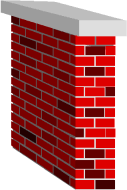Direct and Reverberant Sound
From our discussion in the previous pages on reverberation it should be clear that an enclosure traps sound energy. In a room with a sound source (or sources) emitting a constant sound power, the reverberant background sound builds up to a constant level. The equilibrium sound level occurs when the total sound absorption by the boundaries of the enclosure equals the rate at which sound energy is being injected into the room by the source (or sources). Clearly, a room with high absorptivity, A, will have a lower reverberant sound level (remember high A means that a lot of sound energy is absorbed on each reflection). Conversely, low A means that very little energy is absorbed per reflection and thus the reverberant sound level builds up to a large value. There is a simple formula that can be used to calculate the background reverberant sound level. The formula is
LP = LW + 10log (4/A)
where
LW = 10log (W/W0)
W is the sound power in watts being emitted by the sources in the room. W0 is the reference power level of 10-12 Watts. LW is a decibel value. Note that it is neither sound pressure level or sound intensity level that we studied earlier because it only references Watts (intensity is watts per square meter). The second term in the equation describes the effect of the enclosure; note that all the information on the room is contained in the absorptivity A. Let's do an example.

Example 1.
The air conditioning, telephones, and conversation in a busy office generate an average sound power of 10-5 Watts. The absorptivity, A, of the office is initially 40 Sabins. Calculate the reverberant sound level.
Using W = 10-5 Watts and A = 40 Sabins,
LP = 10log (10-5 / 10-12) + 10log (4 / 40) = 60dB
which means that the background reverberant sound level is 60 dB. This value is rather large. Imagine now that after appropriate wall and ceiling treatments are installed in the office, the absorptivity A increases to 400 Sabins. What is the new reverberant sound level? Again, using W = 10-5 Watts and A = 400 Sabins,
LP = 10log (10-5 / 10-12) + 10log (4 / 400) = 50dB
we see that the reverberant sound level is reduced to 50 dB.
Direct Sound
The reverberant sound level is due to the sound "bouncing around" the enclosure. However, if you are close to the sound source, you will receive more sound energy directly from the source rather than from the reverberant field. We can calculate the direct sound decibel level using the following formula:
LP = LW + 10log (Q / 4πR2)
In this equation, LW has the same meaning as before. R is the distance in meters from the source to the measurement point, and Q is the directivity factor. Q is a number that indicates the location of the source relative to the walls of the enclosure. If the source is far from any of the walls (or ceiling or floor) then Q=1. With Q=1 the equation describes the free field drop of 6 dB every time the distance doubles. You can show this if your algebra is up to speed from the equation above or you can test it by plugging sample numbers into the equation and seeing that the drop in value is 6 dB when the R value is doubled.
Q=2 describes the situation when the source is located next to a large flat surface. The effect of the wall is to reflect the sound energy in the hemisphere behind the source leading to a doubling of the sound energy away from the wall. By a similar argument, if the source is located in a 2 surface corner (for example, in a corner midway between the floor and ceiling) then Q=4. Finally if the source is located in a 3 surface corner (for example, where two walls and the ceiling meet) then Q=8. Let's look at a quick example.

Example 2
How much direct sound is received at 5 m and at 10 m from a source against a wall emitting 10-6 Watts?
Using W=10-6 Watts and R=5 m:
LP = 10log (10-6 /10-12) + 10log (2 / 4π52) = 38dB
Using W=10-6 Watts and R=10 m:
LP = 10log (10-6 /10-12) + 10log (2 / 4π102) = 32dB
of course we get the difference to be 6 dB because the distance from the source doubled from 5 m to 10 m.
Direct and Reverberant Sound Level
Finally, we put the two pieces of the previous equations together to calculate the combined value of the direct and reverberant sound. The equation is given by:
LP = LW + 10log (Q / 4πR2 + 4 / A)
where all the parameters have been described in previous equations. Note that if you are very close to a sound source, R is small and, of the two terms in parentheses, the direct sound term is much larger than the reverberant sound term. You are receiving most of the sound energy directly from the source rather then from the reverberant field. Conversely, if you get very far from the source R is very large and the direct sound term (because it drops off as 1/R2) becomes much smaller than the reverberant sound term. In this case you are receiving the majority of sound energy from the reverberant field rather than directly from the source. In practical terms if you are analyzing the acoustics of an auditorium you most likely want all listeners to receive a direct sound level that is at least comparable to the reverberant sound level so that the sound is clear. This is particularly important for speech.

Example 3
An auditorium with A=620 Sabins has seats ranging from 4 m from the stage to 20 m from the stage. Would a singer who emits an average sound power of 5 x 10-5W be clearly heard in all parts of the auditorium or would you recommend an electronic amplification system?
To solve this problem you need to calculate two values: the reverberant background level and the combined direct and reverberant level. Note that for a person on a stage I take Q=2.
The reverberant level is given by
LP = 10log (5x10-5 / 10-12 ) + 10log (4 / 620) = 55dB
The combined direct and reverberant at 4 m is given by
LP = 10log (5x10-5 / 10-12 ) + 10log (2 /4π42 + 4 / 620) = 59dB
and, finally, the combined direct and reverberant at 20 m is given by
LP = 10log (5x10-5 / 10-12 ) + 10log (2 /4π202 + 4 / 620) = 55dB
Clearly, at 20 m the combined direct and reverberant sound level is just slightly above the reverberant alone. In this case you really cannot tell how much of the direct sound you are receiving. Of course you can calculate it using the direct sound formula--try it; you should find that at 20 m the direct sound level is about 43 dB which is 12 dB below the reverberant background. I think amplifications would be called for in this case.
Homework Exercises
- For a room with A=500 calculate the reverberant background level for a sound source that emits 10-5 Watts. Repeat the calculation for a source that emits 10-3 Watts.
- For the two sources in question 1. calculate the direct sound level alone at distances of 2 m and 10m. Assume Q=1.
- For the two sources in question 1 calculate the combined direct and reverberant sound level at 2 m and at 10 m. Assume Q=1.
- At what distance is the reverberant and direct sounds equal? Hint: look at the second term in the combined direct and reverberant equation--at what R are the two terms equal.
Send me an email at wroberts@mtsu.edu
Contact Information
Dr. W. M. Robertson
MTSU Box X-116
Murfreesboro, TN 37132
Ph. (615) 898-5837


